Decorative Flintlock Pistols. Weapons made with Art and Craftsmanship.
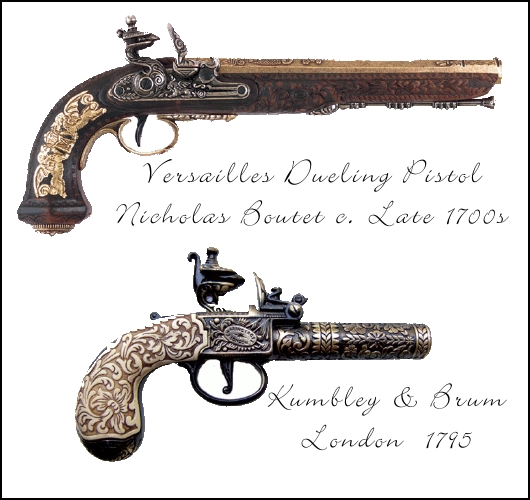
There are some very sleek and modern pistols being produced today, with major advances in technology and accuracy. But they are in a different class from the old flintlock pistols of the past. Ornately engraved and scrolled decorative finishes are something that is no longer produced, except in custom work, made to order at a high price. Many European gunsmiths were producing beautiful flintlock pistols in the 18th and 19th century. The few that have survived are now fetching high prices at auction, or on display in museums.
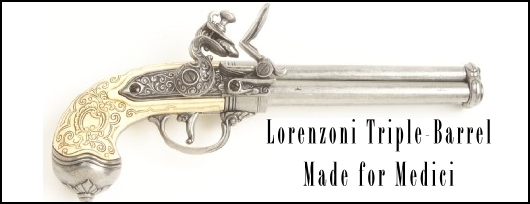
French design is legendary for its
classical elegance and ornate decor. It is evident in French
furniture and architecture. It can also be found in flintlock
muskets and pistols produced by the famed armory at St. Etienne, the
Manufacture d'armes founded in 1764 in Charleville,
France. St. Etienne is only one of many locations
for armories bearing the name. Small arms have been produced
here since the middle ages, including the many weapons used in the
French Revolution and the Napoleonic Wars. Napoleon Bonaparte
himself had personal weapons made here for him by his personal
gunsmith, Jean-Baptiste Gribeauval. Among these are a
double-barrelled flintlock pistol, and Napoleon's personal St. Etienne
1806 traveling flintlock pistol with his crowned mongram "N" on the
grip. Though customized, it is clearly a variation of the AN
XIII flintlock pistol, used by French Cavalry in the Napoleonic
wars. Polished wood, and intricately scrolled brass and
pewter fittings make a resplendent contrast to the plain and the
utilitarian. There are also the Versailles dueling pistols
made by Nicholas Boutet in the time of Napoleon. Carved
exotic woods and precious metals were used in the production of these
pistols, which were presented to high-ranking officials.
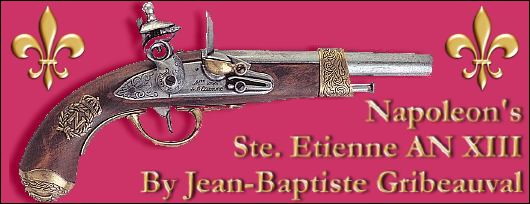
A lot of the St. Etienne flintlocks made
their way to America also. Merriweather Lewis and William
Clark carried some of these flintlock pistols on their famous 1804-1806
expedition to explore the open western lands for expansionist and
president Thomas Jefferson, accompanied by a native-American guide,
Sacajawea. These were variations of the St. Etienne Model AN
IX, which were issued to French infantrymen in the Napoleonic
Wars. Most of these flintlocks can be identified by the
famous St. Etienne stamp in the metal on the side of the lock
mechanism.
Around 1680, Italian gunsmith Lorenzoni produced some magnificent triple-barrel flintlock pistols for the Medici family, with ornately carved ivory grips. Around 1795, Kumbley & Brum of London also made flintlock pistols with beautifully-carved ivory grips and bas-relief brass engraving.
First American President George Washington had
many
pistols, among them, a pair of 1748 Hawkins flintlocks, made in London
with his name engraved
on silver plates on the grips. They are now on
display at
the West Point Military Academy in West Point, New
York. He
was also presented with a brace (pair) of
flintlocks by Gilbert du Motier, the Marquis de LaFayette, who greatly
aided General Washington in the American Revolutionary War.
The
famous first shot of the
American War for Independence, the "Shot heard 'round the world" was
fired in the battle of Lexington and Concord, Massachusetts on April
19, 1775. The pistol that fired that famous shot was a 1760s
Scottish flintlock pistol, an all-metal piece of
extraordinarily ornate design. These are but a few examples
of the fine art and craftsmanship that went into gunmaking in the 17th
through the 19th centuries. When compared with today's
utilitarian, sleek and modern hanguns, which are faster and more
powerful, there is still something magnificent about the time-honored
practice of handcrafted elegance.
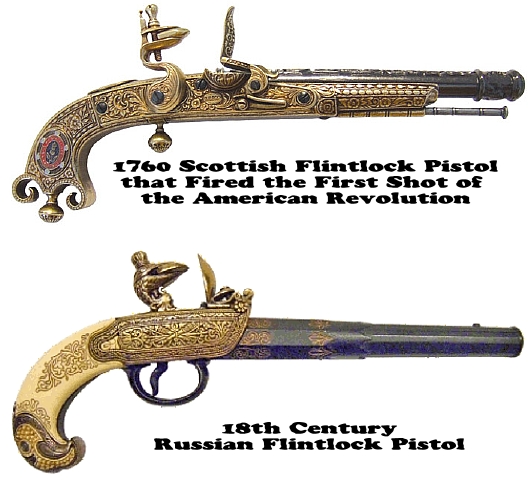
The first flintlock firing mechanism was created by a French courtier for King Louis XIII, and by 1630 was in use in European military engagements. The flintlock mechanism was an improvement on the old "wheel lock" mechanical arrangement, which used a spinning wheel to strike a flint to the black powder. Flintlock weapons were in use for around two hundred years, until they were succeeded by the invention of the percussion cap. In the American Civil War, flintlocks, percussion revolvers and very early self-contained cartridges were all used, at least in some capacity. The percussion "cap and ball" system was a short-lived technology, bridging the gap between flintlocks and the later self-contained metal cartridges. Firearms technology developed rapidly after the introduction of the percussion weapons.
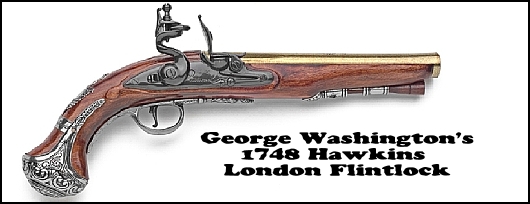
Interested in an Authentic Replica flintlock pistol from the go lden age?
One of our favorites is this richly-detailed and authentic replica o f George Washington's 1748 Hawkins Pistol orignally made in London.
